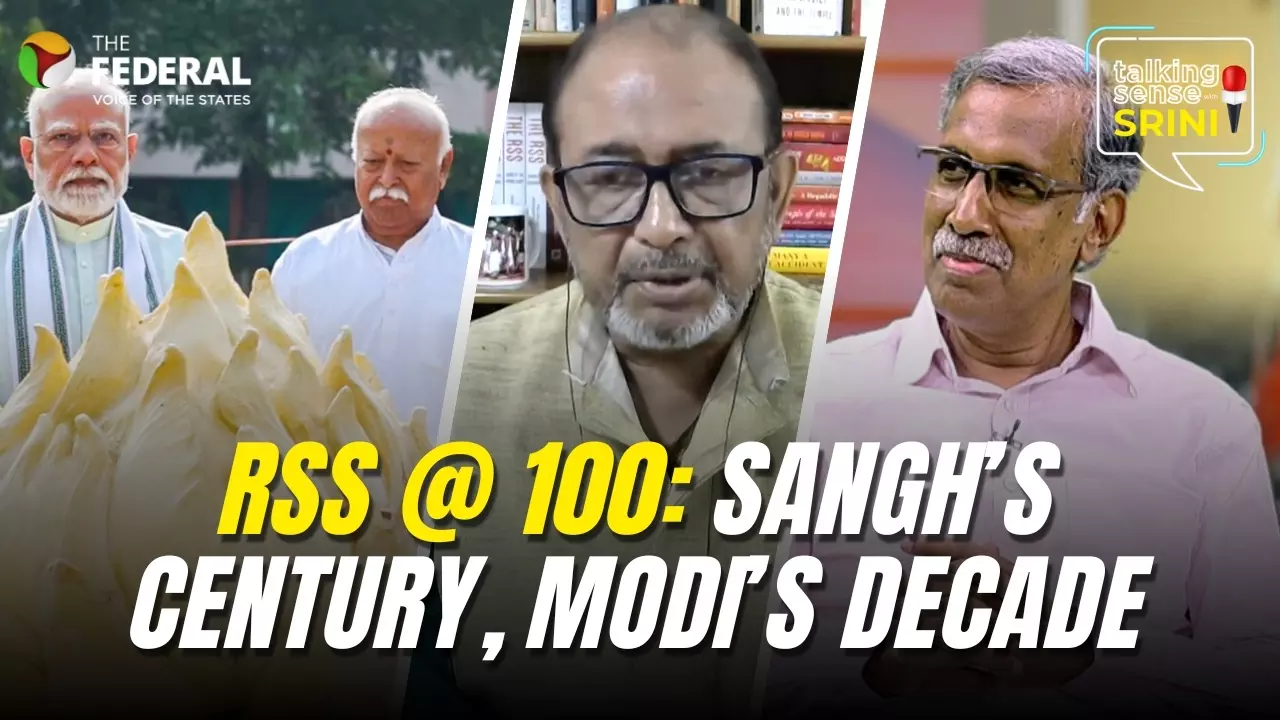
RSS at 100: How relevant is the Sangh in Modi era? | Talking Sense With Srini
The Federal’s Editor-in-Chief S Srinivasan and senior journalist Nilanjan Mukhopadhyay unpack RSS’s evolution, ideological ambitions, and complex ties with BJP under Modi

As the Rashtriya Swayamsevak Sangh (RSS) marks its centenary, its role in shaping India’s political and social landscape remains both influential and contested. In a special edition of Talking Sense with Srini, The Federal’s Editor-in-Chief S Srinivasan and senior journalist and author Nilanjan Mukhopadhyay unpack the Sangh’s evolution, ideological ambitions, and its complex relationship with the BJP under Prime Minister Narendra Modi.
BJP’s ties with RSS under Modi
“The BJP has grown stronger, more confident, and more independent over the past decade,” Srinivasan said. “But that confidence largely stems from Modi himself. The friction between Modi and the RSS actually began when he was in Gujarat, long before he became prime minister.” Srinivasan noted that while Modi started as an RSS pracharak, his rise to national leadership created a power dynamic in which some BJP leaders believed they could function without the Sangh’s guidance.
Read/Watch: Tamilisai interview: 'In TN, Dravidian narrative created misconceptions about RSS'
Yet the RSS remains the ideological backbone of the BJP. Srinivasan emphasised, “Even today, Modi and almost all top BJP leaders come from the Sangh’s ranks. The RSS provides the ideological foundation, particularly the agenda of shaping India as a Hindu nation. The BJP fulfils many of these objectives through government policy, creating a symbiotic yet sometimes tense relationship.”
End of collegial spirit
Mukhopadhyay highlighted how Modi’s leadership style has fundamentally altered the BJP’s organisational structure. “Historically, the BJP functioned collegially, with senior leaders deliberating collectively before decisions were taken. That collegial spirit has disappeared. Today, decisions are centralised, largely resting with Modi and a handful of aides like Amit Shah and JP Nadda,” he said.
Mukhopadhyay noted that despite this autocratic style, Modi has implemented key elements of the RSS agenda, including the construction of the Ram Temple in Ayodhya, the abrogation of Article 370, the Citizenship Amendment Act, and steps toward a uniform civil code in select states.
Read/Watch: RSS at 100 | Was the Sangh anti-colonial? Not at all, says historian
Where RSS vision fails
While the RSS has historically played a decisive electoral role—supporting movements from the Emergency in 1977 to state elections in 2024—Mukhopadhyay said its influence now extends beyond elections. “The RSS also seeks to shape India’s cultural and historical narrative. From textbooks to archaeology, it has systematically promoted its worldview. Economically and technologically, however, its vision remains limited, often diverging from government priorities,” he added.
Srinivasan pointed out that the RSS’s vision for India’s economy is still largely underdeveloped. “On issues like trade and agricultural exports, there is visible divergence between the Sangh and the Modi government,” he said. “Even in foreign policy, the Sangh has limited influence, while Modi’s personal diplomacy has taken centre stage, emphasising visibility and status on the global stage rather than structural economic or strategic agendas," Mukhopadhyay added.
Austere then, contemporary now
The centenary also prompts reflection on the RSS’s internal culture. Srinivasan recalled the organisation’s historic simplicity: leaders lived austere lives, wore modest clothing, and avoided luxury. “Since 2014, things have changed. Modern RSS leaders and BJP politicians now project a more affluent, corporate image, reflecting the realities of contemporary politics,” he said.
Also read: How Trump thwarted RSS’s Vishwaguru dreams, leaving Hindutva project adrift
Caste remains another challenge. Srinivasan and Mukhopadhyay agreed that the RSS’s DNA is still upper-caste dominated. Political expediency has forced some outreach to Other Backward Classes (OBCs) and non-Yadav groups, particularly in states like Uttar Pradesh and Bihar, but the underlying hierarchy persists.
“Attempts at social expansion have been strategic rather than transformative,” Mukhopadhyay said.
Bid at whitewashing image
While the RSS did not play a major role in India’s independence movement, the organisation now seeks to appropriate nationalist icons such as Bhagat Singh and Sardar Patel to bolster its legitimacy. Srinivasan noted, “Perceptions are changing, particularly among younger generations who consume curated narratives through social media. The Sangh is systematically reshaping its image, even as history remains a fixed record.”
Read/Watch: RSS at 100: 'Hindu Mahasabha emerged because Congress avoided religious issues'
A century on, the RSS remains a complex mix of ideology, political influence, and cultural ambition. As Mukhopadhyay summarised, “Its centenary is not just a milestone in time but a reflection of its evolving role in India—shaping politics, social dynamics, and the nation’s broader worldview, often in ways that reflect both continuity and change.”

